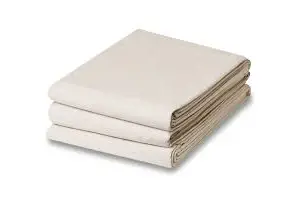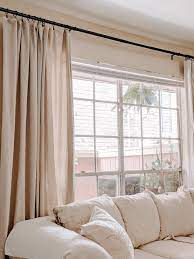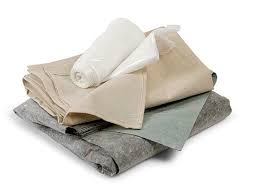Unveiling the Versatility of Drop Cloths: A Comprehensive Exploration.
A drop cloth is a protective sheet used during various projects, primarily made of materials like canvas, plastic, or paper. It shields surfaces from paint, dust, and damage. Canvas drop cloths are durable and absorbent, plastic ones are water-resistant, and paper provides a budget-friendly option. They find applications in painting, construction, crafting, and more. Drop cloths can be repurposed creatively, such as for slipcovers or artistic canvases. The choice between canvas and plastic depends on the project's needs, and alternatives like old sheets or disposable tablecloths can be used when a drop cloth is unavailable.
Exploring Types, Applications, and Creative Uses of Drop Cloths.

In the realm of home improvement and DIY endeavors, certain tools and materials often take center stage, while others quietly perform essential roles in the background. One such unsung hero in the world of renovations and projects is the unassuming drop cloth. Originally designed to shield surfaces from paint splatters, drop cloths have transcended their conventional purpose, emerging as indispensable assets for a myriad of tasks. This comprehensive guide aims to unravel the layers of drop cloths, offering insights into their types, materials, applications, and even delving into creative uses that extend beyond their traditional roles.
Understanding Drop Cloths
Types of Drop Cloths
1.Canvas Drop Cloths:
Canvas drop cloths stand out as one of the most popular choices in the drop cloth universe. Known for their durability and ability to absorb paint spills effectively, canvas drop cloths are woven from cotton or a blend of cotton and synthetic fibers. The thickness of the canvas determines its level of protection, making it suitable for a variety of projects, from painting to light construction work.
2.Plastic Drop Cloths:
Plastic drop cloths, often made of polyethylene or similar materials, are lauded for their water-resistant properties. While they may not offer the same level of absorbency as canvas, they excel in shielding surfaces from liquids, making them ideal for outdoor applications. Plastic drop cloths are a go-to choice when working on projects that involve water-based materials or in situations where quick cleanup is essential.
3.Paper Drop Cloths:
Paper drop cloths are the economical choice in the drop cloth spectrum. Although not as durable as their canvas or plastic counterparts, they still provide a reasonable barrier against paint and spills. Paper drop cloths are often favored for short-term projects or those with minimal mess, offering a budget-friendly option without compromising on protection.
Choosing the Right Material

Selecting the appropriate material for your drop cloth depends on the nature of the project. For painting tasks where absorbency is crucial, canvas drop cloths are an excellent choice. Plastic drop cloths, on the other hand, are better suited for outdoor projects or situations involving liquids. Paper drop cloths offer a cost-effective solution for less messy endeavors.
Applications of Drop Cloths
Painting Projects:
The most common application of drop cloths is in painting projects. Whether you are refreshing the walls of your living room or embarking on an intricate mural, a drop cloth is your first line of defense against accidental spills and drips. Canvas drop cloths are particularly favored for these tasks, providing both absorbency and durability.
Construction and Renovation:
In construction and renovation projects, the versatility of drop cloths truly shines. They can be used to cover and protect floors, furniture, and fixtures from dust, debris, and paint. Plastic drop cloths come into play when shielding surfaces from water or other liquids is paramount. The ease of cleanup and disposal makes them a practical choice for such scenarios.
Crafting and DIY Creations:
Drop cloths extend their utility beyond traditional home improvement tasks into the realm of crafting and DIY creations. The protective barrier they offer ensures that your workspace remains unmarred by glue, paint, or any other crafting materials. Whether you are crafting a masterpiece or assembling intricate DIY projects, a drop cloth provides the necessary protection for your surfaces.
Gardening and Outdoor Activities:
Outdoor activities often involve mess and potential damage to surfaces. Whether you are potting plants, spraying pesticides, or engaging in any other outdoor task, a drop cloth proves invaluable. Plastic drop cloths, in particular, excel in outdoor settings, offering waterproof protection against soil, water, and other outdoor elements.
Creative Uses for Drop Cloths
Slipcovers and Upholstery:
Give new life to old furniture by using drop cloths as slipcovers or upholstery. The neutral color and texture of canvas drop cloths lend themselves well to this creative endeavor. With a bit of sewing prowess, you can transform a mundane piece of furniture into a stylish and customized accent for your home.
Tablecloths and Event Décor:
Hosting an outdoor event or looking to add a rustic touch to your dining table? Large canvas drop cloths can be repurposed into charming tablecloths. Their sturdy nature ensures durability, while their simple elegance adds a touch of sophistication to any gathering.
Canvas for Artistic Expression:
For the aspiring artist, a blank canvas is a quintessential starting point. Unleash your creativity by using a clean canvas drop cloth as your artistic surface. The texture and absorbency of the canvas provide an interesting backdrop for various art forms, from painting to mixed media.
What is drop cloth?

A drop cloth is a protective sheet, typically made of various materials such as canvas, plastic, or paper, used to cover and shield surfaces from paint splatters, dust, and other potential damage during home improvement, painting, crafting, or construction projects.
What is a paint drop cloth used for?
A paint drop cloth is specifically designed to protect floors, furniture, and other surfaces from paint spills, drips, and splatters during painting projects. It acts as a barrier, preventing damage and making cleanup easier.
What kind of plastic is drop cloth?
Drop cloths made of plastic are commonly crafted from polyethylene or similar materials. Polyethylene is a durable and flexible plastic that provides water-resistant properties, making it suitable for protecting surfaces from liquids.
Is drop cloth waterproof?
The water resistance of a drop cloth depends on its material. Plastic drop cloths, particularly those made from polyethylene, are generally waterproof. Canvas drop cloths, while not entirely waterproof, can offer some resistance to liquids due to the tightness of the weave.
What kind of fabric is drop cloth?
Drop cloths can be made from various fabrics, with canvas being a popular choice. Canvas drop cloths are typically woven from cotton or a blend of cotton and synthetic fibers. Other materials include paper and plastic, each with its own set of characteristics.
What is the difference between canvas and drop cloth?
Canvas is a type of fabric, and a canvas drop cloth is a specific application of canvas. When people refer to a "canvas drop cloth," they usually mean a protective sheet made of canvas fabric. The primary difference lies in the usage, with canvas drop cloths designed for protective purposes during projects.
Does drop cloth shrink?
The potential for shrinkage in drop cloths depends on the material. Canvas drop cloths, especially those made primarily of cotton, may experience some shrinkage when exposed to moisture or heat. Plastic and paper drop cloths generally do not shrink.
Is drop cloth durable?

The durability of a drop cloth depends on its material and thickness. Canvas drop cloths are known for their durability and can withstand multiple uses. Plastic drop cloths, though not as robust, are durable for short-term projects, and paper drop cloths are generally less durable.
What can I use instead of a drop cloth?
If a drop cloth is not available, alternatives include old sheets, newspapers, plastic tarps, or even disposable tablecloths. However, the effectiveness of these alternatives may vary, and they might not provide the same level of protection as a purpose-made drop cloth.
How thick should drop cloth be?
The thickness of a drop cloth depends on the intended use. For heavier protection and durability, a thicker canvas drop cloth, measured in ounces per square yard, is recommended. Thinner drop cloths may suffice for lighter tasks or shorter projects.
Can you paint on drop cloth?
Yes, canvas drop cloths, in particular, provide an excellent surface for painting. Artists often use them as makeshift canvases due to their texture and absorbency. It's a creative way to repurpose a drop cloth after its primary protective use.
Is drop cloth plastic?
Drop cloths come in various materials, and while some are made of plastic, others are crafted from canvas or paper. Plastic drop cloths are commonly used for projects where water resistance is crucial, such as outdoor painting or construction tasks.
The drop cloth, often overlooked in its simplicity, proves to be a multifaceted asset in the realm of home improvement, DIY projects, and creative endeavors. Whether you opt for the durability of canvas, the water resistance of plastic, or the budget-friendly option of paper, the right drop cloth can significantly enhance the outcome of your projects. From protecting surfaces during painting and construction to serving as a canvas for artistic expression, the drop cloth's versatility knows no bounds. So, the next time you embark on a project, consider the humble drop cloth as your reliable companion, ready to shield, enhance, and elevate your creative pursuits.



